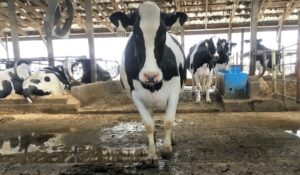For the best health possible for dry cows, does it pay to have two groups? A transition and an early group? or is it better just to have one group? Well, like everything else with dairy operations, it depends.
Weird hearing that from a nutritionist, right? But not all of us are supporters of a two group dry cow program on every farm. Here are some reasons that a farm may choose to go with one group instead of two:
1. Prefresh dry matters are higher than 30 pounds
A 2.2 pound reduction in dry matter can double the risk of subclinical ketosis. If your prefresh dry matters are high, consider a one group diet. If not, the prefresh cows need a separate diet.
2. The pen is at 80% capacity or lower.
Dry cows need their space-about 100 square feet per cow of laying down space and 30 inches of bunk space. Overcrowding cows reduces intakes and causes metabolic issues. If the prefresh cows don’t have enough space in a pen, they need their own group.
3. The diet is similar to the lactating diet.
Similar means you use the same basic forages, even if not in the same amounts as the lactating cows. For example: for the dry cow diet you use straw, corn silage and a little haylage and in the lactating diet you use the haylage and corn silage-you can consider a one group dry cow diet. If the early dry cows get a round bale and some corn silage, and the lactating diet has mostly haylage, a transition diet may be needed to get the cows prepared for the lactating diet.
4. You already have a fresh cow group.
If you already have a fresh group to transition the cows onto the lactating diet, you probably don’t need a two group dry cow diet as well.
5. The condition of the cows is optimal.
If the prefresh cows have good condition without being too fat (typically a 3.0-3.2) , consider a one group ration. If the cows are heavier than that, a 2 group system will help the cows mobilize fat better and help avoid ketosis and fatty liver syndrome.
6. It’s easier to do a one group ration on your farm.
The most important, actually. A poorly executed transition ration, because there isn’t enough time or labor or enough cows in the group is a metabolic problem waiting to happen. In those situations, a one group ration works much better.
One or two, both work on dairies. You just need to figure out what fits best for you.
